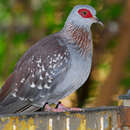en
names in breadcrumbs


The Speckled Pigeon (Columba guinea) is found in a band across Africa from Senegal east to Ethiopia and northwestern Somalia and south to Uganda, western Kenya, southern Tanzania, and northern Malawi; it also occurs in southern Africa from southwestern Angola east to northeastern Zimbabwe and south to the former "Cape Province" (now Northern Cape, Western Cape, and Eastern Cape) in South Africa.
This pigeon, a close relative of the familiar Rock Dove (C. livia), avoids forests, but is found in a variety of habitat types in open country including savanna, open woodland, and gardens from sea level to 3000 m. Western populations are often associated with baobabs and Borassus palms, whereas eastern and southern populations may be associated with rocky terrain, cliffs, and gorges. Ethiopian populations are abundant in grassland and wooded country. In many areas, this species is becoming increasingly urban, expanding its range into farmland and towns and roosting and nesting at high densities on buildings.
Speckled Pigeons forage on the ground, feeding mainly on seeds. Birds may travel up to 25 km from roosting or breeding sites to feed. Breeding occurs year-round across much of the range.
Speckled Pigeons are very common across much of their distribution, with individual flocks sometimes including as many as 700 birds.
(Baptista et al. 1997 and references therein)
The speckled pigeon (Columba guinea), also African rock pigeon or Guinea pigeon, is a pigeon that is a resident breeding bird in much of Africa south of the Sahara. It is a common and widespread species in open habitats over much of its range, although there are sizable gaps in its distribution. It is sometimes referred to as the Guinea pigeon due to its similar coloring to some species of guineafowl.
In 1747 the English naturalist George Edwards included a description and an illustration of the speckled pigeon in the second volume of his A Natural History of Uncommon Birds. His hand-coloured etching was made from two live birds at the home of the Duke of Richmond in London. Edwards was told that the pigeons had been brought from the inland region of Guinea in West Africa.[2] When in 1758 the Swedish naturalist Carl Linnaeus updated his Systema Naturae for the tenth edition, he placed the speckled pigeon with all the other pigeons in the genus Columba. Linnaeus included a brief description, coined the binomial name Columba guinea and cited Edwards' work.[3]
There are two recognised subspecies:[4]
This is a large pigeon at 41 cm in length. Its back and wings are rufous, the latter heavily speckled with white spots. The rest of the upperparts and underparts are blue-grey, and the head is grey with red patches around the eye. The neck is brownish, streaked with white, and the legs are red. Sexes are similar, but immatures are browner than adults and lack the red eye patches. The call is a loud doo-doo-doo.
The speckled pigeon is frequently seen around human habitation and cultivation. Most of its food is vegetable, and it gathers in large numbers where grain or groundnuts are available. This species builds a large stick nest on protected rocky outcrops and in urban areas often atop covered pergola pillars and on flat roofs under deep eaves and lays two white eggs. Its flight is quick, with regular beats and an occasional sharp flick of the wings that are characteristic of pigeons in general.
C. g. guinea, Lake Baringo, Kenya
C. g. bradfieldi, Damaraland, Namibia
C. g. phaeonota with chick in nest, Cape Town, South Africa.
Eggs, Collection Museum Wiesbaden
The speckled pigeon (Columba guinea), also African rock pigeon or Guinea pigeon, is a pigeon that is a resident breeding bird in much of Africa south of the Sahara. It is a common and widespread species in open habitats over much of its range, although there are sizable gaps in its distribution. It is sometimes referred to as the Guinea pigeon due to its similar coloring to some species of guineafowl.